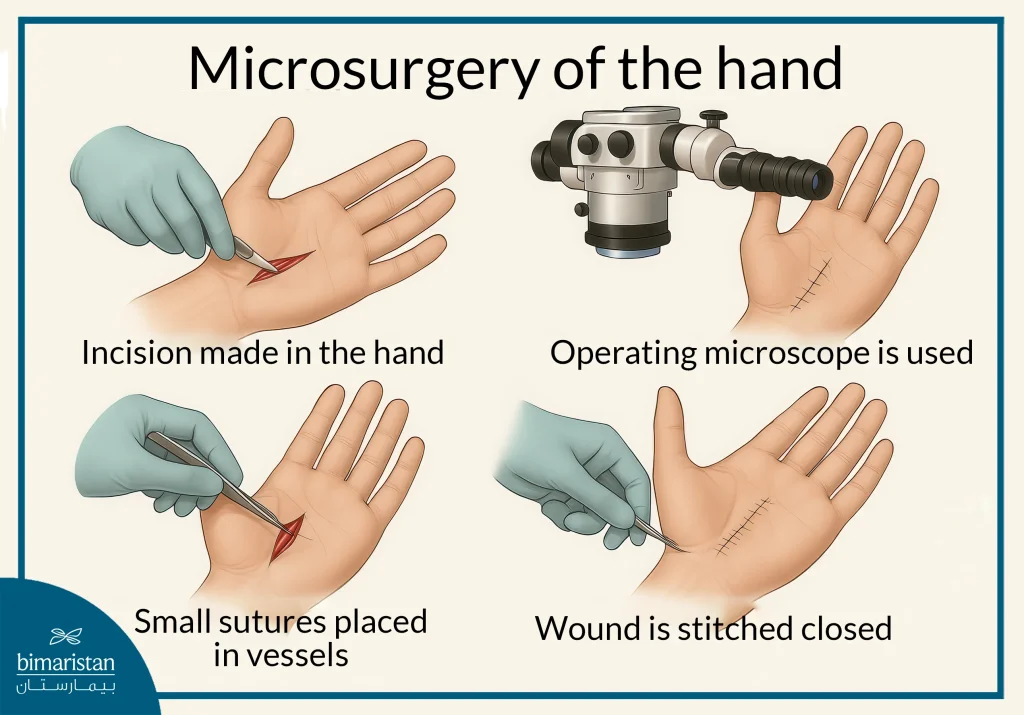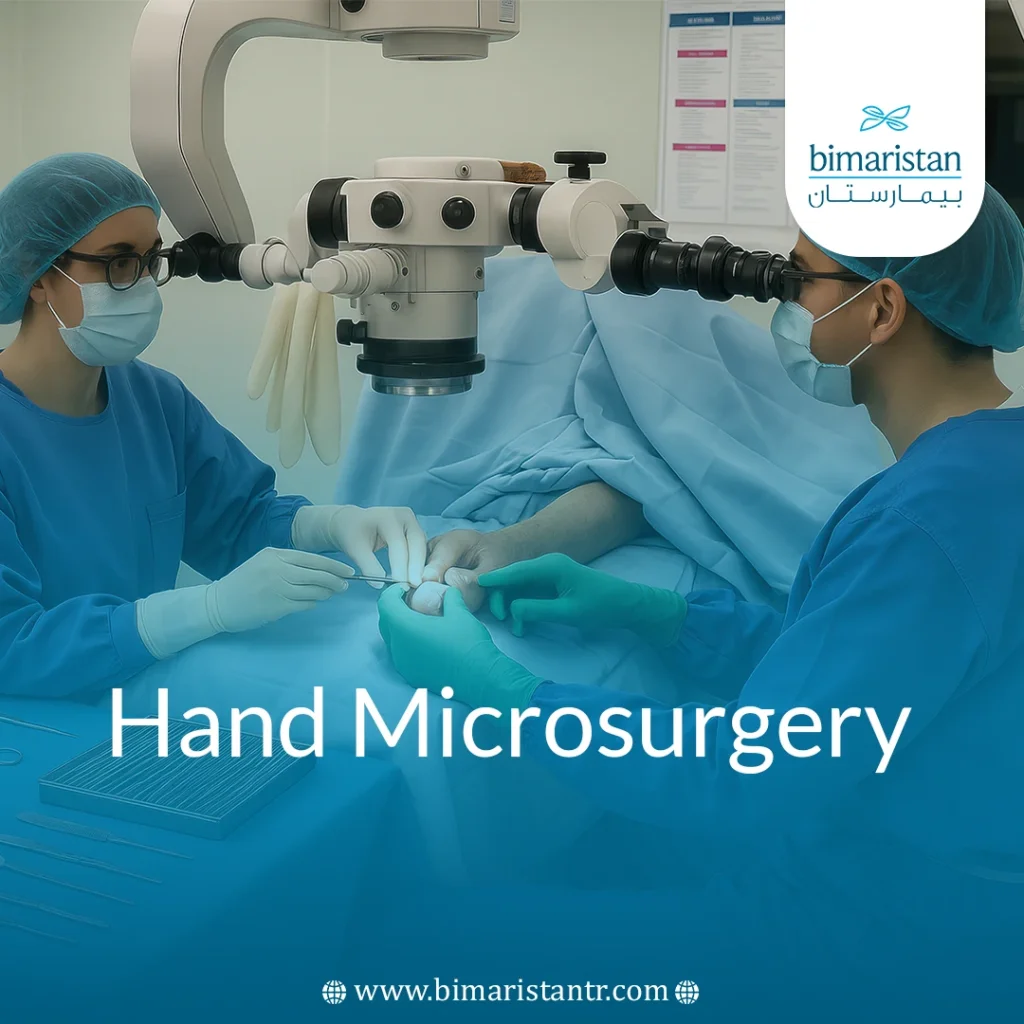In recent decades, the world has seen remarkable progress across various medical disciplines, including hand microsurgery, driven by advancements in surgical technologies and precision instruments. The surgical microscope has become an essential tool for performing delicate operations, enabling surgeons to view tissues, vessels, and nerves with high-resolution detail. This technique is applicable to a broad range of patients, particularly those with microtraumas or requiring the repair of small vessels or nerves, ultimately leading to improved therapeutic outcomes and enhanced motor function.
What is hand microsurgery?
Hand microsurgery is a specialized type of surgery that branches out from hand surgery. It utilizes highly advanced techniques and tools, including high-magnification microscopes and crystal-clear precision, to perform delicate surgeries on the hand and upper limbs. These surgeries treat very delicate tissues, including nerves, blood vessels, and tendons.
The difference between hand microsurgery and conventional surgery:
The key difference here is the transition from dealing with large and prominent structures in conventional surgery to dealing with the finest and smallest tissues in hand microsurgery.
- Conventional surgery: Usually viewed using the naked eye or a magnifying glass, using surgical instruments that are larger and more powerful than microsurgery instruments. Conventional surgery typically addresses large, visible parts of the hand, including bones, major tendons, and large joints.
- Hand microsurgery: A microscope enables the magnification of very small areas, facilitating precise work and minimizing damage to surrounding tissues. Incisions are significantly smaller compared to conventional surgery.
How is hand microsurgery conducted utilizing a microscope?
The patient is placed under appropriate anesthesia. Then, the surgeon uses a surgical microscope with high magnification, which enables the accurate separation of soft tissues, the connection of nerves and vessels, and the performance of complex interventions.
Cases suitable for hand microsurgery
- Fine nerve injuries: Such as cutting or damaging the delicate nerves of the hand that affect sensation or movement.
- Vascular repair: Repair of tiny blood vessels to prevent blood loss and improve blood flow to tissues.
- Small tendon ligations: Such as hand tendon injuries or tears that require high precision to restore mobility.
- Tendonitis: In severe cases, microsurgery may be used.
- Amputated limb transplants: In cases of finger or hand amputations, microsurgery is used to reconnect nerves and vessels, ensuring the survival and function of the transplanted limb.
Getting ready for the surgery
- Examinations and analyses: A comprehensive examination is performed to assess the patient’s health, such as blood tests, X-rays, and MRIs, to ensure their suitability for anesthesia and the procedure.
- Preparing the operating room: The operating room and instruments are thoroughly sterilized and cleaned according to strict protocols. Staff wear specialized clothing, and the lighting and microscopes are adjusted accordingly. Instruments are carefully arranged, and the patient’s hands are prepared for the procedure.
- Tools used: Highly precise instruments, such as forceps, scissors, and specially designed microscopic needles and sutures, are utilized for these delicate procedures.
What is the goal of hand microsurgery?
Aimed at restoring function, relieving pain, and improving the appearance of the damaged hand, it has revolutionized the treatment of complex hand injuries.
Steps of hand microsurgery
- Anesthesia: Local or regional anesthesia is typically used; however, in cases involving complex and lengthy procedures, or for children or uncooperative patients, general anesthesia may be employed.
- Using a surgical microscope: The microscope is positioned above the operating table, and it focuses on the area of injury along with the surgeon’s view.
- Repair of damaged tissues: In this step, the damaged tissues are repaired through appropriate interventions, such as nerve repair, tendon repair, vascularization, or tissue transplantation, as necessary.
- Checking the circulation: The circulation should be checked to ensure that blood flow to the area has returned.
- Wound closure
- Transfer to the patient’s room and awaken the patient

Advantages of hand microsurgery
- High accuracy: Microsurgery is characterized by high precision and a low error rate.
- Greater improvement in movement and sensation scores
- More minor scars and a better cosmetic appearance
Potential Challenges and Risks
Hand microsurgery offers high precision and excellent outcomes, but it presents several challenges for both the patient and the medical team, including:
- Length of procedure
- The highly experienced medical staff required
- Chances of perfusion failure or poor recovery
Finally, microsurgery in general, and hand microsurgery in particular, has emerged as one of the most vital procedures performed on the hand, thanks to advancements in medical instruments and modern surgical techniques. With its superior precision and reduced complication rates compared to conventional surgery, this approach offers safer, more effective results. For further details and personalized information, do not hesitate to reach out to Bimarestan Medical Center.
Sources:
- Koshima, I., Yamamoto, T., Narushima, M., Mihara, M., & Iida, T. (2014). Microsurgery in the urgent and emergent management of the hand. Hand Clinics, 30(2), 251-260
- Lee, W. P., & Lin, C. H. (2011). Soft tissue reconstruction of the hand using microsurgery: An algorithm for the selection of the optimal flap. Hand Clinics, 27(2), 219-231



